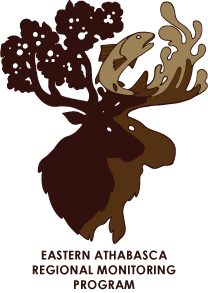EARMP
Initiated in 2011, the Eastern Athabasca Regional Monitoring Program (EARMP) is an environmental monitoring program in northern Saskatchewan. It was designed to monitor potential cumulative effects downstream of uranium mining and milling operations and nearby seven communities in the Athabasca region of northern Saskatchewan.
CUMULATIVE EFFECTS?
Cumulative effects are defined as impacts on the environment that result from the incremental impact of an action when added to other past, present, and foreseeable future actions (Joint Panel 1992).
Cumulative effects might occur when similar projects overlap spatially, such as when two watersheds exposed to mining activities converge. Cumulative effects may also occur temporally due to the potential long-range transport of contaminants over extended periods of time. The EARMP was designed to assess both potential spatial and temporal cumulative effects of uranium mining and milling activities.
SAMPLED?
For the community program, different traditional foods are sampled each year over a three year cycle. The 2019 community program focused on collecting water, fish, and berries. The focus of the 2020 community program will be on water, fish, and mammal chemistry with an additional allotment of supplemental samples.
For the technical program water, fish (flesh and bone), and sediment chemistry as well as benthic invertebrate community data are collected each cycle.
SAMPLE?
The EARMP community study area includes seven communities and six study areas in northern Saskatchewan: Black Lake, Stony Rapids, Fond du Lac, Wollaston Lake/Hatchet Lake, Uranium City, and Camsell Portage.
In addition, the technical sampling program collects samples from far-field exposure areas located downstream of past and present uranium mining and milling operations including Crackingstone Inlet in Lake Athabasca, Fond du Lac River, Cochrane River, and Waterbury Lake. Reference sampling locations are Ellis Bay near Camsell Portage, Cree Lake, and Pasfield Lake.
SAMPLES SUBMITTED?
The water, sediment, wildlife, fish, and berry samples are submitted to the Saskatchewan Research Council (SRC) in Saskatoon, SK. SRC is certified and accredited by the Canadian Association for Environmental Analytical Laboratories (CALA) and the Standards Council of Canada (SCC). As such, SRC adheres to strict QA/QC standards and protocols.
Preserved benthic invertebrate samples are sorted and keyed according to the latest methods and taxonomic keys by the qualified taxonomist, Dr. Jack Zloty, Professor Emeritus from the University of Calgary.
Fish ageing structures are removed and submitted to North Shore Environmental Services in Thunder Bay, ON for age determination of each fish submitted.
SAMPLES TESTED FOR?
A full suite of parameters is assessed for each water, sediment, wildlife, fish, and berry sample. For the technical program, the focus is on the Constituents of Potential Concern (COPCs):
| Aluminum | Organic Carbon * |
| Ammonia* | pH* |
| Arsenic | Polonium-210 |
| Cadmium | Radium-226 |
| Cobalt | Selenium |
| Copper | Specific Conductivity* |
| Iron | Total Hardness |
| Lead | Thorium-230 |
| Lead-210 | Uranium |
| Mercury** | Vanadium |
| Molybdenum | Zinc |
| Nickel |
**Mercury is not associated with the uranium mining and milling process.
Benthic invertebrate community data are summarized using a number of univariate metrics, including density, taxon richness (at the lowest practical level), and biomass.
mercury is not associated with the uranium mining and milling process?
Mercury occurs naturally in the environment and can be found at low levels in most soils and rocks. In northern Saskatchewan, natural deposits associated with lead, zinc, copper, silver, and gold are likely the cause of higher levels of mercury in fish in some lakes (MOE 2015). Since mercury has been identified as a concern of community members in the Athabasca region, it has been included in the assessment; however, it is not specifically linked to the uranium industry’s processes.
the funding for the program?
EARMP is funded by the Province of Saskatchewan, the Canadian Nuclear Safety Commission (CNSC) in partnership with Cameco Corporation (Cameco) and Orano Canada Inc. (Orano).
the sample collection and manages the EARMP program?
Canada North Environmental Services (CanNorth) manages the program and works directly with Indigenous residents in the seven Athabasca communities to collect both the technical and community samples for the EARMP.
CanNorth is a Saskatchewan-based company that has been providing environmental services to Canadian industrial and resource developments, government agencies, and Indigenous and local communities for over 30 years. The company is 100% owned by Kitsaki Management Limited Partnership (KMLP), the investment arm of the Lac La Ronge Indian Band (LLRIB); therefore, CanNorth is 100% First Nation owned. For more information about CanNorth, please visit www.cannorth.com.
the results and who has access to the data?
A fundamental objective of the EARMP program is to provide the public access to all information collected. To that end, all reports are available electronically in our Reports section.
the rationale for how the technical program is designed? How might it change over time?
The overall approach used for the EARMP technical monitoring program includes the assessment of both chemical and benthic invertebrate community endpoints over the long-term. The core elements of the study design are believed to remain relatively consistent over time; however, the program is also adaptive and may be refined in response to new information or changes associated with development in the region.
Some things to consider are:
The development of additional mining and milling operations in the region that may influence the sampling locations.
Changes to the design of the EARMP technical program may occur based on results and conclusions from each monitoring cycle.
contact those involved with EARMP if I have questions or concerns regarding the program?
We value your feedback. Please send us an email at info@earmp.com or visit our Contact Us page.
Saskatchewan Ministry of the Environment (MOE). 2015. Mercury in Saskatchewan fish: guidelines for consumption. Website: Accessed October 2019.

